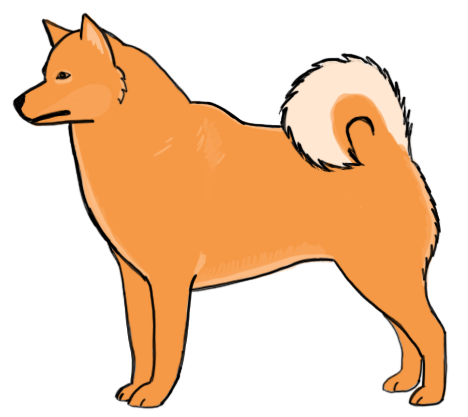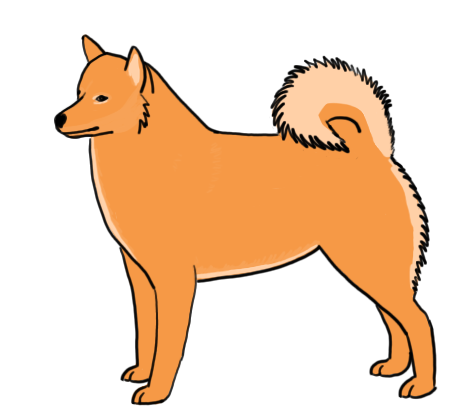The Finnish Spitz is a hunting dog of the Spitz family originating from Finland.
In their native Finland, Finnish Spitz are still used for hunting, mostly for a large game bird called a capercaille and for black grouse. However, in North America, they are primarily companion dogs.
Appearance and Size
Finnish Spitz have a square build and a fox-like look. Both its temperament and conformation are perfect for tireless and active hunting, even in the coldest weather.
Its fox-like appearance and other characteristic features are a tribute to its northern heritage (dense double coat, small erect ears, and curled tail). Its double coat, comprising a straight and harsh outer coat and a short soft undercoat, provides warmth in cold weather.
The Finnish Spitz is yellowish or reddish brown in colour. The colour is usually bright. It is adorned with attractive lighter hair in the back thighs and some times in the shape of reins on the sides, in addition to which the inner arch of the tail is light.
Size : The Finnish Spitz in considered as a medium sized dog.
Males are 17 1/2 to 19 1/2 inches (40-50 cm) tall and weigh 31 to 35 pounds (14-16kg).
Females are 15 1/2 to 17 1/2 inches (39-45 cm) tall and weigh 22 to 29 pounds (10-13 kg).










Temperament
The Finnish Spitz is known to be playful, alert, and curious. He is also a sensitive dog that is completely devoted to its human companion. Similar to other spitz breeds, the Finkie is stubborn and independent.
Even though the breed is good with children, he can be cautious, aloof, and reserved with strangers.
Although the Finnish Spitz can survive outdoors in cool and temperate climates, it prefers living indoors, as he craves social contact. Because it is a lively and active breed, the Finnish Spitz requires daily physical exercise such as a long on-leash walk or a run around the park.
There is no big difference between male and female when it comes to temperament or behavior, and this is even more true if you have your Finnish spitz spayed or neutered.
With Children and other Pets
Finnish Spitz love children and will tolerate a lot, walking away when they’ve had too much. Since the Finnish Spitz is a medium sized dog he will not risque to be injured by a small kid and will feel also less stressed than a smaller breed around them. You will also feel more comfortable to watch this medium sized dog around your kids than with a bigger breed.
That said, you should always teach children how to approach and touch dogs, and always supervise any interactions between dogs and young children to prevent any biting or ear or tail pulling on the part of either party. Teach your child never to approach any dog while he’s sleeping or eating or to try to take the dog’s food away. No dog, no matter how good-natured, should ever be left unsupervised with a youg child.
Finnish Spitz get along well with other dogs and cats, especially if they’re raised with them, but they can be aggressive toward dogs they don’t know. With rodents and pets birds you will need to stay cautious because of the Finnish Spitz hunting instinct.
Training
Finnish Spitz have a lot of energy and high exercise needs. They aren’t recommended for apartment dwellers or families who don’t have the time and energy to give them a lot of exercise.
He prefers cooler climates and does well as an inside dog. When you take him for a walk in public places, such as parks, be sure to keep him on leash so he won’t take off chasing something. Give your Finnish Spitz a couple of 30-minute walks daily to help him use up his energy
Training these independent, strong-willed dogs can be a challenge. They are best trained with a soft voice and touch. Their intelligence makes them become easily bored with repetitive training, so keep your training sessions short. Professional trainers say that Finnish Spitz can be manipulative and too smart for their owners, so you need to be persistent and firm. If you stick with it, however, you’ll be greatly rewarded by your dog’s intelligence and aptitude for sports such as obedience, agility, and rally.
Since barking was the Finnish Spitz original purpose, he takes pride in its ability to bark a lot, even showing off this trait at every opportunity.
If left alone in the backyard, a Finnish Spitz will probably engage in his favorite activity — barking! So if you are planning to have a Finkie for companion and you have close neighbors, you’ll need to train your dog to stop barking or hope that your neighbors are very tolerant.
It’s not a difficult task as soon as you start training him as soon as he gets in your home as a puppy.
His next favorite activity in your garden will be hunting for prey, which can include digging for mice and other burrowing animals or chasing squirrels and birds. This is a breed that requires a knowledgeable, and patient owner.
Also, keep in mind that Finnish Spitz are slow to mature. It generally takes about four years for them to become mentally mature. In the years building up to that, your Finnish Spitz will need time to decide whether or not he’s going to accept you as the leader of the pack. Some male Finkies can be dominating, and are aware of their positions in the hierarchy.
At times, he’ll be silly and rebellious; other times he’ll be self-contained and contemplative. A Finnish Spitz doesn’t tolerate being bullied, but with consistency, fairness, and patience, you’ll gain his respect and obedience.
Finnish Spitz want to be members of the family and are naturally protective. They are sensitive dogs and don’t do well in homes where there’s a lot of tension. But give them a loving atmosphere and include them in everything you do and they’ll become a loyal, lively, and fun-loving friend.
Grooming
With weekly brushing, Finnish Spitz stay exceptionally clean. Their coats aren’t oily, so they typically don’t have an odor. They shed heavily in the spring and fall, however, and will need additional brushing during that time to keep the hair from flying around.
Bathe only as needed. The Finnish Spitz is a wash-and-wear dog, meaning that no trimming should be done except under the pads of the feet.
Other grooming needs include dental hygiene and nail care. Brush your Finnish Spitz’s teeth at least two or three times a week to remove tartar buildup and the accompanying bacteria. Daily is better.
Trim his nails preferably twice a month. If you can hear the nail clicking on the floor, they’re too long. Short nails keep the feet in good condition and won’t scratch your floors.
Health and Feeding
Finnish Spitz, which have an average lifespan of 12 to 14 years, are typically a very healthy breed.
However, like all breeds, there may be some health issues, like hip dysplasia, patellar luxation, epilepsy and eye disease. Some dogs may be faced with these health challenges in their lives, but the majority of Finnish Spitz are healthy dogs.
Finnish Spitz love to eat and will do their best to get some extra treats. Finnish Spitz can easily became overweight, which can lead to health problems.
Obesity can be a significant health problem in Finnish Spitz. It is a serious disease that may cause or worsen joint problems, metabolic and digestive disorders, back pain and heart disease.
So be careful not to overfeed them!

